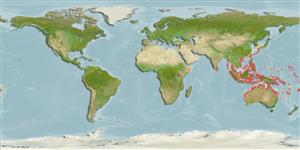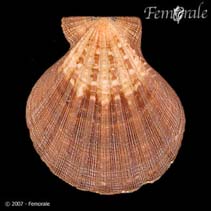Decatopecten radula (Linnaeus, 1758)
Flatribbed scallop| Native range | All suitable habitat | Point map | Year 2050 |

|
| This map was computer-generated and has not yet been reviewed. |
| Decatopecten radula AquaMaps Data sources: GBIF OBIS |
Classification / Names Common names | Synonyms | CoL | ITIS | WoRMS
| Pectinida | Pectinidae
Environment: milieu / climate zone / depth range / distribution range Sinh thái học
; Mức độ sâu 0 - 20 m (Ref. 348). Tropical
Sự phân bố Các nước | Các khu vực của FAO | Các hệ sinh thái | Những lần xuất hiện | Những chỉ dẫn
Indo-West Pacific: from India to Melanesia; north Japan and south to Queensland and New Caledonia.
Length at first maturity / Bộ gần gũi / Khối lượng (Trọng lượng) / Age
Maturity: Lm ? range ? - ? cm Max length : 9.5 cm SHL con đực/không giới tính; (Ref. 348); common length : 7.0 cm con đực/không giới tính; (Ref. 348)
Short description Hình thái học
Shell solid, medium sized, higher than long, elongate-ovate in outline. Both valves convex, the right (lower) valve more inflated than the left (upper) valve. Ears subequal in size and shape. Right anterior ear with a slight byssal notch anteroventrally, devoid of ctenolium. Outer sculpture of about 10 or 11 rounded radial folds (9 to 13) on each valve, with numerous, much smaller, secondary radial riblets that are set with densely and finely imbricated transverse scales, giving a rather strongly scabrous aspect. Surface of ears with distinct radial ridges (more developed on right anterior ear). Hinge line quite long, about 2/3 of shell length, with shallow marginal ridges. Interior of valves shiny, with a flattened radial sculpture corresponding with the outer folds. Colour: outside of shell off-white to interior satin white, with dark brown on the hinge line.
Attached to rock, coral and other hard objects. Common on coarse sand in coral reef areas. Intertidal and shallow subtidal waters (Ref. 348).
Life cycle and mating behavior Chín muồi sinh dục | Sự tái sinh sản | Đẻ trứng | Các trứng | Sự sinh sản | Ấu trùng
Members of the class Bivalvia are mostly gonochoric, some are protandric hermaphrodites. Life cycle: Embryos develop into free-swimming trocophore larvae, succeeded by the bivalve veliger, resembling a miniature clam.
Main reference
Các tài liệu tham khảo | Người điều phối | Người cộng tác
Poutiers, J.M. 1998. (Ref. 348)
IUCN Red List Status (Ref. 130435)
CITES status (Ref. 108899)
Not Evaluated
CMS (Ref. 116361)
Not Evaluated
Threat to humans
Harmless
Human uses
| FishSource |
Các công cụ
Thêm thông tin
Các nước
Các khu vực của FAO
Các hệ sinh thái
Những lần xuất hiện
Những chỉ dẫn
Stocks
Sinh thái học
Thức ăn
Các loại thức ăn
Các khu vực của FAO
Các hệ sinh thái
Những lần xuất hiện
Những chỉ dẫn
Stocks
Sinh thái học
Thức ăn
Các loại thức ăn
Tên thường gặp
Các synonym ( Các tên trùng)
Các động vật ăn mồi
Sự tái sinh sản
Chín muồi sinh dục
Đẻ trứng
Sự sinh sản
Các trứng
Egg development
Các synonym ( Các tên trùng)
Các động vật ăn mồi
Sự tái sinh sản
Chín muồi sinh dục
Đẻ trứng
Sự sinh sản
Các trứng
Egg development
Các nguồn internet
BHL | BOLD Systems | CISTI | DiscoverLife | FAO(Publication : search) | Fishipedia | GenBank (genome, nucleotide) | GloBI | Gomexsi | Google Books | Google Scholar | Google | PubMed | Cây Đời sống | Wikipedia (Go, tìm) | Tạp chí Zoological Record
Estimates based on models
Preferred temperature
(Ref. 115969): 25 - 29.3, mean 28.6 (based on 2509 cells).



